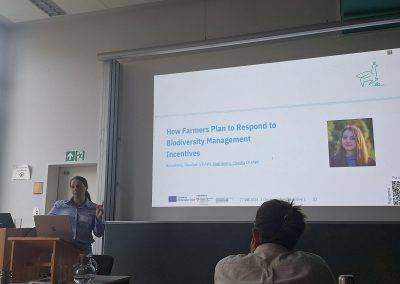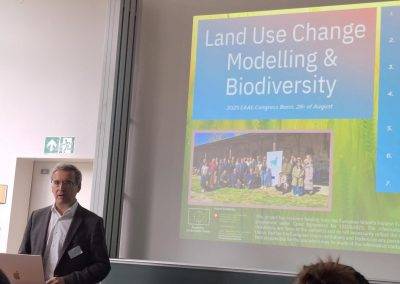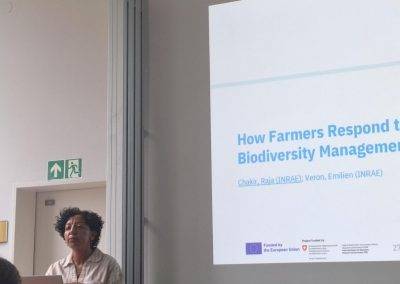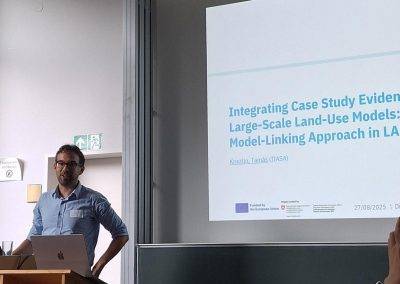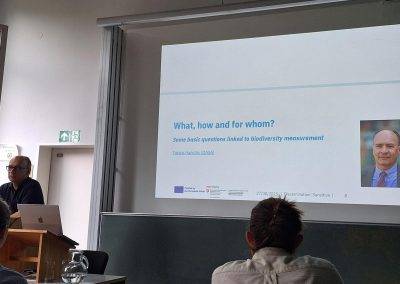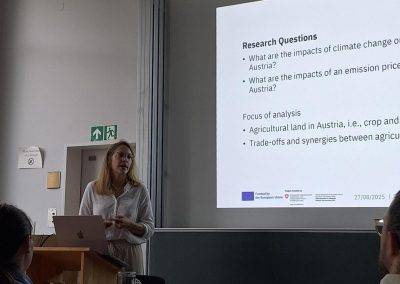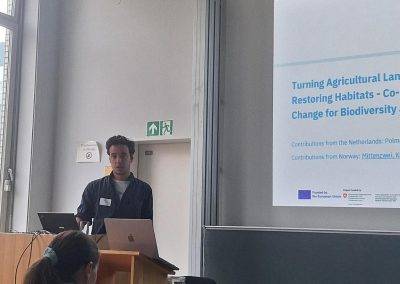Impressions and highlights of the EAAE conference 2025
The LAMASUS project partners made a strong impact at the European Association of Agricultural Economists (EAAE) conference 2025 that took place on 26-29 August, in Bonn, Germany. Here is a summary of the LAMASUS participation.
Organised Session: OS4 –Land Use, Biodiversity and Climate Policy, showcased LAMASUS research on how policies and land-use changes affect biodiversity and climate neutrality.
- Franz Sinabell (WIFO) and Tassos Hanniotis (IIASA): Modelling Agricultural Land Use Changes in the Context of Recent European Biodiversity
Agriculture and forestry dominate land use in Europe. The Nature Restoration Law, central to the EU Biodiversity Strategy, sets binding ecosystem restoration targets for all EU Member States (and relevant EEA members). Using LAMASUS modelling toolkits, case studies explore (i) how agricultural policies affect biodiversity, and (ii) options to improve cost-effectiveness and participation in conservation measures. Covering arable land, wetlands, and Alpine pastures, the studies highlight trade-offs, land-use conflicts, and complementarities between biodiversity and climate neutrality policies. - Támas Krisztin (IIASA): Integrating Case Study Evidence Into Large-Scale Land-Use Models.
Presented a model-linking approach that bridges insights from regional case studies with EU-wide land-use models. The presentation highlighted the challenges of balancing local detail versus large-scale coherence and discussed strategies to improve predictive capacity while ensuring empirical realism. - Anna Renhart (WIFO), Verena Kroener & Erwin Schmid (BOKU): Marginal Agricultural Land, Land Abandonment and Loss of Habitats – Evidence from Austria.
Examined the fate of Alpine pastures, where traditional grazing sustains biodiversity. Using econometric analysis, the team identified drivers of land abandonment, while optimization modelling tested policy scenarios such as grazing support or afforestation. The results provide guidance for designing cost-effective policies to preserve mountain habitats. - Nico Polman (WUR), Klaus Mittenzwei (RURALIS) & Walter Rossi Cervi (WUR): Turning Agricultural Land to Wetlands and Restoring Habitats.
Investigated rewetting organic soils and converting arable land into grasslands in the Netherlands and Norway. Using farm-level and spatial-economic models, the results showed how such measures can cut GHG emissions while improving biodiversity. They compared Norway’s peatland cultivation ban with Dutch payment schemes for dairy farmers, revealing economic trade-offs and environmental benefits. - Raja Chakir & Emilien Veron (INRAE): How Farmers Respond to Biodiversity Management Incentives.
Analysed parcel-level data (2015–2022) and found that organic farmers significantly increase hedgerow density, unlike conventional farmers. The study suggests that aligning hedgerow subsidies with organic farming could double policy efficiency, reinforcing landscape conservation while supporting organic agriculture. - Raushan Bokusheva & Claudia Magnapera (ZHAW): How Farmers Plan to Respond to Biodiversity Management Incentives.
Used conservation auctions to explore German farmers’ preferences for eco-friendly practices such as cover crops and hedgerows. Results showed that result-based payments and market-based mechanisms can drive adoption more effectively than flat-rate eco-schemes, offering valuable policy insights.
The session closed with a discussion led by Franz Sinabell (WIFO), underlining that policies promoting biodiversity can complement climate neutrality strategies.
Organised Paper Session: OS1 – Machine Learning-Based Surrogate Modeling for Agricultural Economic Models
Chairs: Hugo Storm (University of Bonn) & Tamás Krisztin (IIASA)
This session discussed how machine learning is transforming agricultural and climate policy modelling.
- Tamás Krisztin & Leopold Ringwald (IIASA): Calibration of Economic Land-Use Models with Surrogate Approaches: Enhancing the GLOBIOM Model.
Applied Bayesian Additive Regression Trees (BART) to calibrate GLOBIOM against real-world land-use data. The approach showed improved predictions for grassland and natural land dynamics, addressing long-standing calibration challenges. - Wolfgang Britz & Hugo Storm (University of Bonn): Surrogate Modeling of a Multi-Regional Global CGE Model to Optimize a Global Social Welfare Function.
Demonstrated how Machine Learning surrogates of CGE models enable the optimization of global climate policies (e.g., emissions trading systems) that would otherwise be computationally infeasible.
Contributions to individual sessions
- Emilien Veron & Raja Chakir (INRAE): The Role of Organic Farming in Landscape Conservation.
Discussed how farms converting to organic farming rapidly increased hedgerow density, especially cereal farms. Simulations suggested that targeting subsidies at organic farms could cut costs of restoration policies by up to 60%. - Raja Chakir, Berk Oktem & Emilien Veron (INRAE, Université Paris Saclay): Droughts and Agricultural Land Concentration in France.
Using 30 years of data, the presentation showed that recurrent droughts accelerate farm consolidation, reducing land prices and pushing smallholders out. By 2100, average farm size could rise by 35 hectares under severe scenarios. - François Bareille, Raja Chakir & Derya Keles (INRAE): Land-Use Adaptation to Climate Change.
Analysed 1990–2018 satellite data to show that climate explains around 10% of all land-use changes in Europe, with colder regions expanding agriculture and warmer regions shifting land towards urban uses.
Conclusion: LAMASUS partners demonstrated how integrated research and modelling can shape effective, climate-smart policies. By linking feedback from local and regional experiences, innovative data, and advanced simulation tools, the project is at the forefront of guiding Europe’s journey towards sustainable land use, biodiversity protection, and climate neutrality.

